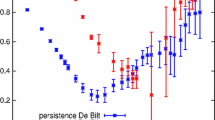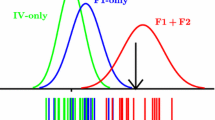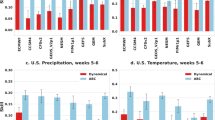Abstract
We describe a new approach that allows for systematic causal attribution of weather and climate-related events, in near-real time. The method is designed so as to facilitate its implementation at meteorological centers by relying on data and methods that are routinely available when numerically forecasting the weather. We thus show that causal attribution can be obtained as a by-product of data assimilation procedures run on a daily basis to update numerical weather prediction (NWP) models with new atmospheric observations; hence, the proposed methodology can take advantage of the powerful computational and observational capacity of weather forecasting centers. We explain the theoretical rationale of this approach and sketch the most prominent features of a “data assimilation–based detection and attribution” (DADA) procedure. The proposal is illustrated in the context of the classical three-variable Lorenz model with additional forcing. The paper concludes by raising several theoretical and practical questions that need to be addressed to make the proposal operational within NWP centers.




Similar content being viewed by others
References
Allen MR (2003) Liability for climate change. Nature 421:891–892
Baum LE, Petrie T, Soules G, Weiss N (1970) A maximization technique occurring in the statistical analysis of probabilistic functions of Markov chains. Ann Math Stat 41(1):164–171
Balmaseda MA, Alves OJ, Arribas A, Awaji T, Behringer DW, Ferry N, Fujii Y, Lee T, Rienecker M, Rosati T, Stammer D (2009) Ocean initialization for seasonal forecasts. Oceanography Special Issue 22(3)
Bengtsson L, Ghil M, Källén E (1981) Dynamic meteorology: Data assimilation methods. Springer-Verlag, New York
Bhend J, Franke J, Folini D, Wild M, Brönnimann S (2012) An ensemble-based approach to climate reconstructions. Clim Past 8:963–976
Bocquet M, Pires CA, Wu L (2010) Beyond Gaussian statistical modeling in geophysical data assimilation. Mon Wea Rev 138:2997–3023
Bocquet M (2012) Parameter-field estimation for atmospheric dispersion: application to the Chernobyl accident using 4D-Var. Quart J Roy Meteor Soc 138:664–681
Bucklew JA (2004) Introduction to rare event simulation. Springer
Carrassi A, Vannitsem S (2010) Model error and variational data assimilation: A deterministic formulation. Mon Wea Rev 138:3369–3386
Carrassi A, Ghil M, Trevisan A, Uboldi F (2008) Data assimilation as a nonlinear dynamical systems problem: Stability and convergence of the prediction-assimilation system. Chaos: An Interdisciplinary Journal of Nonlinear Science 18(2):023–112
Chekroun MD, Simonnet E, Ghil M (2011) Stochastic climate dynamics: Random attractors and time-dependent invariant measures. Phys D 240(21):1685–1700. doi:10.1016/j.physd.2011.06.005
Chevallier F (2013) On the parallelization of atmospheric inversions of CO2 surface fluxes within a variational framework. Geosci Model Dev Discuss 6:37–57
Christidis N, Stott PA, Scaife A A, Arribas A, Jones G S, Copsey D, Knight J R, Tennant W J (2013) A New HadGEM3-A-Based System for Attribution of Weather- and Climate-Related Extreme Events. J Clim 26(9):2756–2783
Cosme E, Brankart JM, Verron J, Brasseur P, Krysta M (2006) Implementation of a reduced-rank, square-root smoother for ocean data assimilation. Ocean Model 33:87–100
Dalcher A, Kalnay E, Hoffman RN (1988) Medium-range lagged average forecasts. Mon Wea Rev 116:402–416. doi:10.1175/1520-0493. 1988116<0402:MRLAF>2.0.CO;2.
Del Moral P, Garnier J (2005) Genealogical particle analysis of rare events. Ann Appl Probab 15(4):2496–2534
Evensen G (2003) The ensemble Kalman filter: theoretical formulation and practical implementation. Ocean Dyn 53:343–367
Gardiner C (2004) Handbook of stochastic methods for physics, Chemistry and the natural sciences. Publisher. Pls.; no web tonite
Gelb A (1974) Applied optimal estimation. M.I.T. Press, Cambridge
Ghil M, Childress S (1987) Topics in geophysical fluid dynamics: Atmospheric dynamics, dynamo theory and climate dynamics. Springer-Verlag, New York, p 485
Ghil M, Malanotte-Rizzoli P (1991) Data assimilation in meteorology and oceanography. Adv Geophys 33:141–266
Ghil M, Cohn S, Tavantzis J, Bube K, Isaacson E (1981). In: Bengtsson L, Ghil M, Källén E (eds) Applications of estimation theory to numerical weather prediction. In: Dynamic meteorology: Data assimilation methods. Springer Verlag, pp 139–224
Gini C (1921) Measurement of inequality of incomes. Econ J 31(121):124–126. doi:10.2307/2223319
Greenland S, Rothman KJ (1998) Measures of effect and measures of association, Chapter 4. In: Rothman K J, Greenland S (eds) Modern Epidemiology, 2nd edn.,Lippincott-Raven, Philadelphia, USA
Hannart A, Pearl J, Otto FEL, Naveau P, Ghil M (2015) Counterfactual causality theory for the attribution of weather and climate-related events. Bull Am Meteorol Soc. in press
Harris T E, Kahn H (1951) Estimation of particle transmission by random sampling. Natl Bur Stand Appl Math Ser 12:27–30
Heidelberg P (1995) Fast simulation of rare events in queueing and reliability models. ACM Trans Models Comput Simul 5:43–85
Hewitt C, Mason S, Walland D (2012) The global framework for climate services. Nat Clim Change 2:831–832
Hoffman RN, Kalnay E (1983) Lagged average forecasting, an alternative to Monte Carlo forecasting. Tellus 35A:100–118. doi:10.1111/j.1600-0870.1983.tb00189.x
Houtekamer PL, Mitchell HL, Pellerin G, Buehner M, Charron M (2005) Atmospheric data assimilation with an ensemble Kalman filter: Results with real observations. Mon Wea Rev 133:604–620
Hürzeler M, Künsch HR (2001). In: Doucet A, De Freitas JFG, Gordon NJ (eds) Approximation and maximising the likelihood for a general state-space model. In: Sequential Monte Carlo Methods Practice. Springer-Verlag, New York
Ide K, Courtier P, Ghil M, Lorenc A (1997) Unified notation for data assimilation: Operational, sequential and variational. J Meteor Soc Japan 75:181–189
Ihler AT, Kirshner S, Ghil M, Robertson AW, Smyth P (2007) Graphical models for statistical inference and data assimilation. Phys D 230:72–87
Jazwinski AH (1970) Stochastic and filtering theory. Mathematics in sciences and engineering series 64 :376
Kalman RE (1960) A new approach to linear filtering and prediction problems. J Basic Eng 82D:33– 45
Kantas N, Doucet A, Singh SS, Maciejowski JM (2009) An overview of sequential Monte Carlo methods for parameter estimation. In: General state-space models, IFAC System Identification, no. Ml
Kondrashov D, Sun CJ, Ghil M (2008) Data assimilation for a coupled ocean-atmosphere model. Part II: Parameter estimation. Mon Wea Rev 136:5062–5076. doi:10.1175/2008MWR2544.1
Kondrashov D, Shprits Y, Ghil M (2011) Log-normal Kalman filter for assimilating phase-space density data in the radiation belts. Space Weather 9:S11006. doi:10.1029/2011SW000726
Lee TCK, Zwiers FW, Tsao M (2008) Evaluation of proxy-based millennial reconstruction methods. Climate Dyn 31:263–281
Lorenz EN (1963) Deterministic non-periodic flow. J Atmos Sci 20:130–141
Lorenz MO (1905) Methods of measuring the concentration of wealth. Publications of the American Statistical Association 9(70):209–219. doi:10.2307/2276207
Martin MJ, et al. (2014) Status and future of data assimilation in operational oceanography. J of Oper Ocean. in press
Massey N, Jones R, Otto FEL, Aina T, Wilson S, Murphy JM, Hassell D, Yamazaki YH, Allen MR (2014) weather@home — development and validation of a very large ensemble modelling system for probabilistic event attribution. Q J R Meteorol Soc. doi:10.1002/qj.2455
Otto FEL, Boyd E, Jones RG, Cornforth RJ, James R, Parker HR, Allen MR (2015) Attribution of extreme weather events in Africa: a preliminary exploration of the science and policy implications. Climatic Change
Palmer TN (1999) A non-linear dynamical perspective on climate prediction. J Clim 12:575–591
Pearl J (2000) Causality: Models, reasoning and inference. Cambridge University Press, Cambridge
Pitt MK (2002) Smooth particle filters for likelihood evaluation and maximisation. Warwick Economic Research Papers, No. 651
Robert C, Blayo E, Verron J (2006) Comparison of reduced-order sequential, variational and hybrid data assimilation methods in the context of a Tropical Pacific ocean model. Ocean Dyn 56:624–633
Roques L, Chekroun MD, Cristofol M, Soubeyrand S, Ghil M (2014) Parameter estimation for energy balance models with memory. Proc R Soc A 470:20140349
Ruiz J, Pulido M, Miyoshi T (2013) Estimating model parameters with ensemble-based data assimilation: A review. JMSJ 91(2):79–99
Sakov P, Counillon F, Bertino L, Lister KA, Oke PR, Korablev A (2012) TOPAZ4: an ocean-sea ice data assimilation system for the North Atlantic and Arctic. Ocean Sci 8:633–656. doi:10.5194/os-8-633-2012
Stone DA, Allen MR (2005) The end-to-end attribution problem: from emissions to impacts. Clim Change 71:303–318
Stott PA, et al. (2013). In: Asrar GR, Hurrell J W (eds) Attribution of weather and climate-related events, in: Climate Science for Serving Society: Research, Modelling and Prediction Priorities. Springer. in press
Stott PA, Stone DA, Allen MR (2004) Human contribution to the European heatwave of 2003. Nature 432:610–614
Talagrand O (1997) Assimilation of observations, an introduction. J Meteor Soc Japan 75(1B):191–209
Tandeo P, Pulido M, Lott F (2014) Offline parameter estimation using EnKF and maximum likelihood error covariance estimates: Application to a subgrid-scale orography parametrization. Q J R Meteorol Soc. doi:10.1002/qj.2357
Trenberth K E, Fasullo J T, Shepherd T G (2015) Attribution of climate extreme events. Nature Clim Change 5:725–730
Wiener N (1949) Extrapolation, Interpolation and smoothing of stationary time series, with engineering applications. M.I.T. Press, Cambridge, p 163
Wouters J, Bouchet F (2015) Rare event simulation of the chaotic Lorenz 96 dynamical system. Geophysical Research Abstracts, EGU General Assembly 2015 Vol. 17, EGU2015-10421-1
Acknowledgements
It is a pleasure to thank Fredi Otto and Dáithí Stone, who provided careful and constructive reviews of the original paper. This work has been supported by grant DADA from the Agence Nationale de la Recherche (ANR, France: AH and all co-authors) and by the Multi-University Research Initiative (MURI) N00014-12-1-0911 from the the U.S. Office of Naval Research (MG).
Author information
Authors and Affiliations
Corresponding author
Appendices
Appendix A Illustration of the computational benefit of the DADA approach
To illustrate the computational benefit, let Y be for instance a d-variate autoregressive process defined by Y t+1 = A Y t +w t , where w t is an i.i.d. noise having known PDF g(⋅) and where A has the usual properties that insure stationarity (Gardiner 2004). We then have:
with π(⋅) the prior PDF on the initial state Y 0. Equation 7a shows that f(y) can be easily computed using a closed-form expression, while P(ϕ(Y)≥u) in Eq. 7b is an integral on d×T+1 dimensions which must instead be evaluated by using, for instance, a computationally quite costly Monte-Carlo (MC) simulation.
Appendix B Data Assimilation
The state-estimation problem for the system given by Eq. 4a and 4b has an exact solution given by the following sequential Kalman filter (KF) equations:
where \(^{\prime }\) denotes the transpose operation. Here Eq. 8a and 8b are referred to as the analysis step and denoted by a superscript a, while the forecast step is given by Eq. 8c and 8d, and is denoted by a superscript f (Ide et al. 1997). The vector \({\mathbf {x}^{a}_{t}}\) and the matrix \(\mathbf {P^{a}_{t}}\) are the mean and covariance of X t conditional on (Y 1,...,Y t )=(y 1,...,y t ); \(\mathbf K=\mathbf {P^{f}_{t}}\mathbf H^{\prime }(\mathbf H\mathbf {P^{f}_{t}}\mathbf H^{\prime }+\mathbf R)^{-1}\) is the so-called Kalman gain matrix; while Q and R are the covariances associated with v t and w t , respectively. Following (Wiener 1949), one distinguishes between filtering, in which \({\mathbf {x}^{a}_{t}}\) and \(\mathbf {P^{a}_{t}}\) are conditioned only on the previous and current observations (y 0,...,y t ), and smoothing, in which they are conditioned on the entire sequence, 0≤t≤T. Furthermore, the sequential algorithm needs to be initialized at time t=0 with \({\mathbf {x}_{0}^{f}}\) and \(\mathbf {P}_{0}^{f}\), which thus represent the a priori mean and covariance of X 0, respectively, and have to be prescribed by the user.
Appendix C Derivation of the model evidence
In this appendix, we outline the derivation of model evidence within a general Bayesian framework, and we apply the latter to the narrower KF context to obtain Eq. 5. Consider two consecutive cycles of a DA run, the first with state vector x t and observation vector y t at instant t and the subsequent one with state vector x t+1 and observation vector y t+1 at instant t+1. We plan to find a tractable expression for the model evidence p(y t ,y t+1).
The model evidence provided by the full sequence of observations y=(y 0,...,y T ) will be inferred by recursion, using the results of this two-observation setting. In order to decouple the two cycles, one first has to spell out the Bayesian inference p(y t ,y t+1) = p(y t )p(y t+1|y t ). We look for a tractable expression for p(y t+1|y t ) by further introducing the states x t+1 and x t as intermediate random variables:
where p(y t+1|x t+1) is the likelihood of the observation vector y t+1 conditional on the state vector x t+1 and it is known from Eq. 4b. The conditional PDF p(x t |y t ) of x t on y t at instant t — which appears on the right-hand side of the above equation — is referred to as the analysis PDF in the DA literature, where it is denoted by a superscript a (Ide et al. 1997), and it constitutes the main DA output. The integral \({\int }_{\mathbf {x}_{t}} \! p(\mathbf {x}_{t+1} | \mathbf {x}_{t}) p(\mathbf {x}_{t} | \mathbf {y}_{t})\,\mathrm {d}\mathbf {x}_{t}=p(\mathbf {x}_{t+1} | \mathbf {y}_{t})\), in which p(x t+1|x t ) is known from the model dynamics given by Eq. 4a, propagates this analysis PDF further in time, to instant t+1. Hence, the result of this integration coincides with the forecast PDF, denoted by superscript f in the DA literature (Ide et al. 1997). It follows that this decomposition is tractable using a DA scheme that is able to estimate the conditional and forecast PDFs.
Next, let us apply the general Bayesian inference (9) to the case in which all the PDFs involved are Gaussian; this requires, in turn, that both the dynamics and observation models M and H be linear, and that the input statistics all be Gaussian. In this case, the Kalman filter allows for the exact computation of the PDFs mentioned in Eq. 9, which turn out to be Gaussian.
In the following, \({\mathcal {N}}(\overline {\mathbf {x}},\mathbf {P})\) designates the Gaussian PDF of mean \(\overline {\mathbf {x}}\) and covariance matrix P. In this context, the analysis PDF at instant t is \({\mathcal {N}}({\mathbf {x}^{a}_{t}},{\mathbf {P}^{a}_{t}})\), where \({\mathbf {x}^{a}_{t}}\) and \({\mathbf {P}^{a}_{t}}\) are the analysis state and error covariance matrix at instant t. As a result of the linearity assumptions, the forecast PDF at instant t+1 is given by a Gaussian distribution \({\mathcal {N}}(\mathbf {x}^{f}_{t+1},\mathbf {P}^{f}_{t+1})\), where \(\mathbf {x}^{f}_{t+1}\) and \(\mathbf {P}^{f}_{t+1}\) are the forecast state and error covariance matrix at instant t+1. Further, the integration on x t+1 in Eq. 9 can readily be performed under these circumstances, with the outcome that p(y t+1|y t ) is distributed as \({\mathcal {N}}(\mathbf {H}\,\mathbf {x}^{f}_{t+1},\mathbf {R}+\mathbf {H}\,\mathbf {P}^{f}_{t+1}\,\mathbf {H}^{\prime })\).
The desired model evidence f(y) can then be computed by recursion on successive time steps as:
here p(y 0) represents the prior PDF of the initial state, \(\boldsymbol {\Sigma }_{t} = \mathbf {R}+{\mathbf {H}\mathbf {P}^{f}_{t}}\mathbf {H}^{\prime }\), and this expression coincides with Eq. 5 and can be evaluated with the help of any DA method that yields the forecast states and forecast error covariance matrices, such as the KF or the EnKF. Note that the traditional standard Kalman smoother would give the same result as the KF, since they share the same forecasts.
Finally, Eqs. 9 and 10 above show that the likelihood f(y) may be obtained as a by-product of the inference on the state vector x, which usually is the main purpose in numerical weather prediction. This idea may actually be highlighted in even greater generality by considering the equality:
While Eq. 11 is a direct consequence of Bayes theorem, it also illustrates a point that is arguably not so intuitive. The likelihood f(y) is obtained here as the ratio of two quantities: a numerator p(y|x)p(x) that is a model premise inherently postulated by Eq. 4a and 4b, and a denominator p(x|y) that may be viewed as the end result of the primary inferxence on x. In other words, estimating f(y) requires only a straightforward division, provided x has been previously inferred.
Equation 11 thus expresses with great clarity and simplicity a fundamental idea buttressing our proposal, as it provides a general theoretical justification for the suggestion of deriving the likelihood from an inferential treatment that focuses on x. To put it succintly, this equation basically says, “He who can do more can do less.” In the context of DA, whose end purpose is to infer the state vector x out of an observation y — i.e., the more part — it is possible to obtain the likelihood as a by-product thereof — i.e., the less part — and thus almost for free.
Appendix D PDF of the state vector
We associate a label ω∈Ω with each realization of the random process v t that drive the model given by Eq. 6. The PDF of the state vector x t can be obtained as the numerical solution of the corresponding Fokker-Planck equation, and it is the mean over Ω of the sample measures obtained for each realization ω of the noise v t and (Chekroun et al. 2011, and references therein). Each sample measure is supported on a random attractor that may have very fine structure and be time-dependent (Chekroun et al. 2011, Figs. 1–3 and supplementary material), but the PDF is supported smoothly, in the counterfactual world in which λ 0=0, on a “thickened” version of the fairly well-known strange attractor of the original L63 model. The latter PDF represents its attractor in dynamic system’s terminology.
Rights and permissions
About this article
Cite this article
Hannart, A., Carrassi, A., Bocquet, M. et al. DADA: data assimilation for the detection and attribution of weather and climate-related events. Climatic Change 136, 155–174 (2016). https://doi.org/10.1007/s10584-016-1595-3
Received:
Accepted:
Published:
Issue Date:
DOI: https://doi.org/10.1007/s10584-016-1595-3




